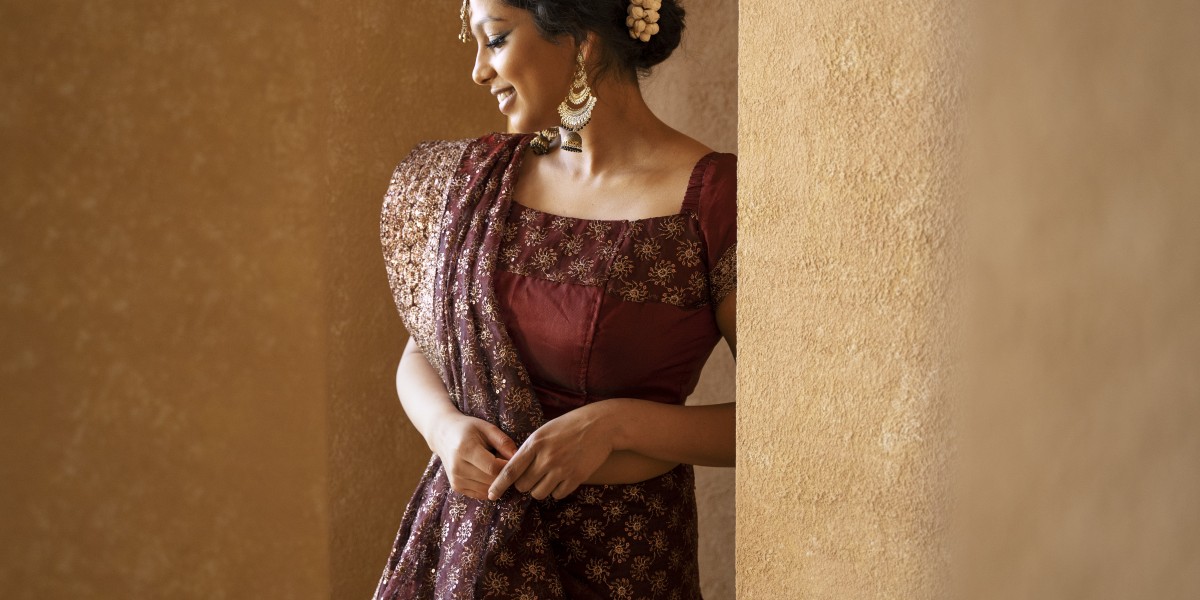There are few garments in the Indian fashion universe that hold as much cultural prestige and artistic value as the Banarasi weave. Known for its breathtaking motifs, shimmering zari work, and regal finesse, Banarasi silk has remained a symbol of heritage and elegance for centuries. Whether worn at weddings, festive events, or formal gatherings, its appeal never fades. Today, as traditional handloom experiences a revival, the timeless Banarasi aesthetic continues to dominate Indian couture—blending age-old artistry with modern interpretations.
The story of Banarasi handloom begins in the ancient lanes of Varanasi, where skilled artisans have been crafting these fine textiles for generations. Each creation is woven with intricate attention to detail and can take anywhere from days to months to complete, depending on the complexity of the design. This deep devotion to craftsmanship is what gives every piece a life of its own. For many, the first touch of a Banarasi drape feels like stepping into history—an embrace of tradition, pride, and artistry.
The Heritage of Handwoven Splendor
The Banarasi Silk Saree weave is renowned for its exquisite zari—fine threads of gold or silver woven into the fabric to form spectacular motifs. While earlier designs were heavily inspired by Mughal aesthetics such as floral vines, creepers, and jaal patterns, modern artisans have expanded their creativity to incorporate geometric shapes, birds, minarets, and even contemporary abstract elements. The results are pieces that seamlessly blend classical and modern influences.
Each Banarasi textile is crafted on a handloom, requiring precision and patience. Artisans often inherit their weaving skills from their ancestors, ensuring that generations of tradition remain alive. The bond between the craft and the craftsmen is unbreakable, and their dedication is what makes every creation exceptional.
Signature Banarasi Styles That Define Royalty
The world of Banarasi weaving is incredibly diverse. From the rich brocades to the delicate kora silks, each variety is distinct and mesmerizing. Here are some signature styles that continue to remain favorites:
1. Katan Silk Banarasi
Known for its pure mulberry silk threads, Katan Banarasi is luxurious, smooth, and graceful. The tightly woven fabric displays vibrant colors and patterns, making it ideal for bridal wear and grand celebrations. Its softness and rich texture make it both comfortable and regal.
2. Organza and Kora Banarasi
These variations are lighter and translucent, often adorned with intricate zari or resham embroidery. Their ethereal charm makes them perfect for summer weddings, day events, or occasions requiring subtle elegance.
3. Tissue Banarasi
With its natural sheen and metallic undertone, Tissue Banarasi stands out as one of the most glamorous styles. The shimmering surface adds an instant festive glow, while the lightweight texture offers effortless draping.
4. Tanchoi Weaves
Tanchoi Banarasi is admired for its satin-like finish and minimal or no zari use. Instead, it features elaborate woven patterns created using colorful silk threads. Its artistic finesse makes it a favorite among women who appreciate understated luxury.
5. Jangla and Jaal Designs
These are among the most elaborate designs in Banarasi artistry. Jangla features large floral patterns, while jaal consists of interconnected motifs spread across the fabric. These styles are often selected for weddings due to their grandeur.
Modern Interpretations and Evolving Fashion
While the traditional six-yard drape remains iconic, modern designers have been exploring new ways to reinterpret Banarasi weaves. Today, the fabric is used in lehengas, gowns, jackets, kurtas, blouses, and even fusion silhouettes like pantsuits and capes. This expansion has introduced Banarasi craftsmanship to a younger audience and global fashion enthusiasts.
The rising popularity of sustainable fashion has also played a role in its resurgence. Consumers today appreciate garments with meaningful craftsmanship, ethical production, and cultural roots. The Banarasi weave perfectly aligns with these values, making it a favorite among conscious shoppers worldwide.
Why the Banarasi Tradition Remains Timeless
There is something undeniably majestic about a Banarasi ensemble. Its weighty drape, rich sheen, and detailed motifs combine to create a look that feels both royal and emotional. Many families treasure these weaves as heirlooms, passing them down from one generation to the next. This continuity of tradition strengthens the cultural significance of the garment.
Additionally, a Banarasi Silk Saree is one of the few classic outfits that transcends regional boundaries. Women across India—and even abroad—admire its sophistication. Whether paired with antique jewelry, temple designs, or contemporary accessories, it adapts beautifully to various styles and preferences.
For brides, owning a Banarasi Silk Saree is often considered essential. Its ornate look, combination of tradition and glamor, and aura of purity make it a cherished choice for wedding ceremonies. Many families consider it a symbol of blessing and prosperity.
Even in everyday life, fashion lovers continue to rediscover the versatility of a Banarasi Silk Saree, pairing it with modern blouses, belts, and statement jewelry to create fresh looks that honor tradition while embracing creativity.
In Conclusion
Handwoven Banarasi textiles represent far more than fashion—they embody legacy, craftsmanship, and cultural pride. Their exquisite weaves continue to inspire designers and captivate fashion enthusiasts across generations. As the world grows more appreciative of handmade artistry, Banarasi styles stand tall as some of India’s most treasured creations. Whether worn at a celebration, preserved as an heirloom, or cherished as a symbol of heritage, the Banarasi weave remains a timeless masterpiece.








